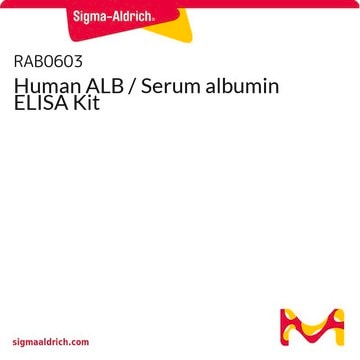MAK124
BCG Albumin Assay Kit
sufficient for 250 colorimetric tests
Synonym(s):
Bromocresol Green Albumin Assay
Sign Into View Organizational & Contract Pricing
All Photos(1)
About This Item
UNSPSC Code:
12161503
NACRES:
NA.84
Recommended Products
usage
sufficient for 250 colorimetric tests
detection method
colorimetric
relevant disease(s)
genitourinary disorders; gastrointestinal diseases
storage temp.
−20°C
Gene Information
human ... ALB(213)
mouse ... ALB(11657)
rat ... ALB(24186)
General description
Albumin is the most abundant plasma protein in humans. It accounts for ∼60% of the total serum protein. Albumin plays important physiological roles, including maintenance of colloid osmotic pressure and binding of key substances such as long-chain fatty acids, bile acids, bilirubin, hematin, calcium, and magnesium. It has antioxidant and anticoagulant effects, acts as a carrier for nutritional factors and drugs, and is an effective plasma pH buffer. Serum albumin is a reliable prognostic indicator for morbidity and mortality, liver disease, nephritic syndrome, malnutrition, and protein-losing enteropathies. High levels are associated with dehydration.
Application
- LncRNA ZEB1-AS1 inhibits renal fibrosis in diabetic nephropathy by regulating the miR-217/MAFB axis.: This research utilizes the BCG Albumin Assay Kit to quantitatively analyze albumin levels in studies of diabetic nephropathy. The results demonstrate the regulatory role of lncRNA on miR-217/MAFB axis, contributing significantly to the understanding and potential treatments of kidney fibrosis in diabetic patients (Song et al., 2019).
- Albumin depletion of human plasma also removes low abundance proteins including the cytokines.: This study employs the BCG Albumin Assay Kit to investigate the effects of albumin depletion in human plasma, specifically its impact on the presence of low abundance proteins such as cytokines. The findings are crucial for the refinement of proteomic analyses and understanding protein interactions in biological samples (Granger et al., 2005).
Features and Benefits
Compatible with high-throughput handling systems. Can be adapted for use with cuvettes.
Suitability
Suitable for the detection of Albumin in serum, plasma, urine, and other biological samples.
Principle
The BCG (Bromocresol Green) albumin assay kit is designed to measure albumin directly without any pretreatment of samples. The optimized formulation substantially reduces interference by other substances (lipids/other proteins) in the raw samples. It may also be used to measure effects of drugs and other compounds on albumin metabolism. The procedure involves addition of a single working reagent and a 5 minute incubation. The optimized formulation has greatly enhanced reagent and signal stability. The kit utilizes bromocresol green, which forms a colored complex specifically with albumin. The intensity of the color, measured at 620 nm, is directly proportional to the albumin concentration in the sample.
Storage Class Code
12 - Non Combustible Liquids
Flash Point(F)
Not applicable
Flash Point(C)
Not applicable
Certificates of Analysis (COA)
Search for Certificates of Analysis (COA) by entering the products Lot/Batch Number. Lot and Batch Numbers can be found on a product’s label following the words ‘Lot’ or ‘Batch’.
Already Own This Product?
Find documentation for the products that you have recently purchased in the Document Library.
Customers Also Viewed
Marvin Gonzalez-Quiroz et al.
BMC nephrology, 20(1), 21-21 (2019-01-18)
After two-years of follow-up of 263 apparently healthy 18- to 30-year-old men in communities affected by Mesoamerican nephropathy (MeN), we identified three distinct case groups: a subgroup with (i) established renal dysfunction (case-group 1); individuals with (ii) a rapid decline in
Alaa T Alshareeda et al.
PloS one, 12(8), e0184004-e0184004 (2017-08-30)
Hepatocellular carcinoma (HCC) is considered the 3rd leading cause of death by cancer worldwide with the majority of patients were diagnosed in the late stages. Currently, there is no effective therapy. The selection of an animal model that mimics human
Yin-Ting Yeh et al.
Scientific reports, 8(1), 13623-13623 (2018-09-13)
Blood is a complex fluid consisting of cells and plasma. Plasma contains key biomarkers essential for disease diagnosis and therapeutic monitoring. Thus, by separating plasma from the blood, it is possible to analyze these biomarkers. Conventional methods for plasma extraction
Gillian E Conway et al.
Mutagenesis, 35(4), 319-330 (2020-08-12)
Following advancements in the field of genotoxicology, it has become widely accepted that 3D models are not only more physiologically relevant but also have the capacity to elucidate more complex biological processes that standard 2D monocultures are unable to. Whilst
Jun Li et al.
Kidney international, 95(3), 611-623 (2019-01-28)
Chronic antibody-mediated rejection is the leading cause of allograft dysfunction and loss after kidney transplantation, and current immunosuppressive regimens fail to target the plasma cells that produce alloantibodies. We previously showed that treatment with the immunoproteasome inhibitor ONX 0914 prevented
Our team of scientists has experience in all areas of research including Life Science, Material Science, Chemical Synthesis, Chromatography, Analytical and many others.
Contact Technical Service





